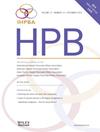Implementation of robotic and laparoscopic hepatopancreatobiliary surgery in low- and middle-income settings: a systematic review and meta-analysis
IF 2.4
3区 医学
Q2 GASTROENTEROLOGY & HEPATOLOGY
引用次数: 0
Abstract
Background
Despite numerous barriers, the application of minimally invasive surgery (MIS) for hepatopancreatobiliary (HPB) conditions has been increasing globally. This study aims to review the current status of HPB MIS in LMICs.
Methods
Relevant databases were searched, identifying 3452 publications, 38 of which met the inclusion criteria. Meta-analysis of outcomes was carried out using “R” statistical software.
Results
This study reviewed reports of application of MIS for HPB conditions in LMICs, analyzing a total of 3272 procedures. India (66.87 %) and Egypt (20.11 %) contributed majorly to the procedures reviewed. Others were from Indonesia (8.68 %), Colombia (3.06 %), Pakistan (0.67 %), Sri Lanka (0.34 %), Trinidad and Tobago (0.18 %), and Nigeria (0.09 %). India was the only LMIC with robotic HPB MIS. The majority of the procedures were biliary (74.88 %). Basic procedures accounted for 55.63 %, while 44.37 % were advanced. The overall conversion rate and prevalence of morbidity were 8 % [95 % CI: 5; 13], and 15 % [95 % CI: 9; 22], respectively. Robotics was associated with higher conversion (14 % vs 6 %, p < 0.01) but lower morbidity (10 % vs 16 %, p = 0.91), compared to laparoscopic surgery. There were 5 cases of mortality from laparoscopy.
Conclusion
The outcomes in this systematic review, compared to findings in other settings indicate successful implementation of HPB MIS in LMICs.
实施机器人和腹腔镜肝胆管手术在低收入和中等收入的设置:系统回顾和荟萃分析。
背景:尽管存在诸多障碍,微创手术(MIS)在肝胆胰(HPB)疾病中的应用在全球范围内不断增加。本研究旨在综述HPB MIS在中低收入国家的现状。方法:检索相关数据库,共检索文献3452篇,其中符合纳入标准的文献38篇。采用“R”统计软件对结果进行meta分析。结果:本研究回顾了MIS在低收入国家HPB条件下的应用报告,共分析了3272例程序。印度(66.87%)和埃及(20.11%)对审查的程序作出了主要贡献。其他来自印度尼西亚(8.68%)、哥伦比亚(3.06%)、巴基斯坦(0.67%)、斯里兰卡(0.34%)、特立尼达和多巴哥(0.18%)和尼日利亚(0.09%)。印度是唯一拥有机器人HPB管理信息系统的低收入国家。大多数手术是胆道手术(74.88%)。基本程序占55.63%,先进程序占44.37%。总转换率和发病率为8% [95% CI: 5;[13], 15% [95% CI: 9;22),分别。机器人技术与更高的转换率相关(14% vs 6%, p)。结论:与其他情况下的结果相比,本系统综述的结果表明HPB MIS在中低收入国家的成功实施。
本文章由计算机程序翻译,如有差异,请以英文原文为准。
求助全文
约1分钟内获得全文
求助全文
来源期刊

Hpb
GASTROENTEROLOGY & HEPATOLOGY-SURGERY
CiteScore
5.60
自引率
3.40%
发文量
244
审稿时长
57 days
期刊介绍:
HPB is an international forum for clinical, scientific and educational communication.
Twelve issues a year bring the reader leading articles, expert reviews, original articles, images, editorials, and reader correspondence encompassing all aspects of benign and malignant hepatobiliary disease and its management. HPB features relevant aspects of clinical and translational research and practice.
Specific areas of interest include HPB diseases encountered globally by clinical practitioners in this specialist field of gastrointestinal surgery. The journal addresses the challenges faced in the management of cancer involving the liver, biliary system and pancreas. While surgical oncology represents a large part of HPB practice, submission of manuscripts relating to liver and pancreas transplantation, the treatment of benign conditions such as acute and chronic pancreatitis, and those relating to hepatobiliary infection and inflammation are also welcomed. There will be a focus on developing a multidisciplinary approach to diagnosis and treatment with endoscopic and laparoscopic approaches, radiological interventions and surgical techniques being strongly represented. HPB welcomes submission of manuscripts in all these areas and in scientific focused research that has clear clinical relevance to HPB surgical practice.
HPB aims to help its readers - surgeons, physicians, radiologists and basic scientists - to develop their knowledge and practice. HPB will be of interest to specialists involved in the management of hepatobiliary and pancreatic disease however will also inform those working in related fields.
Abstracted and Indexed in:
MEDLINE®
EMBASE
PubMed
Science Citation Index Expanded
Academic Search (EBSCO)
HPB is owned by the International Hepato-Pancreato-Biliary Association (IHPBA) and is also the official Journal of the American Hepato-Pancreato-Biliary Association (AHPBA), the Asian-Pacific Hepato Pancreatic Biliary Association (A-PHPBA) and the European-African Hepato-Pancreatic Biliary Association (E-AHPBA).
 求助内容:
求助内容: 应助结果提醒方式:
应助结果提醒方式:


